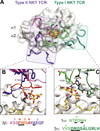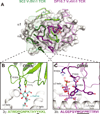Coevolution of T-cell receptors with MHC and non-MHC ligands
- PMID: 26284470
- PMCID: PMC4544829
- DOI: 10.1111/imr.12327
Coevolution of T-cell receptors with MHC and non-MHC ligands
Abstract
The structure and amino acid diversity of the T-cell receptor (TCR), similar in nature to that of Fab portions of antibodies, would suggest that these proteins have a nearly infinite capacity to recognize antigen. Yet all currently defined native T cells expressing an α and β chain in their TCR can only sense antigen when presented in the context of a major histocompatibility complex (MHC) molecule. This MHC molecule can be one of many that exist in vertebrates, presenting small peptide fragments, lipid molecules, or small molecule metabolites. Here we review the pattern of TCR recognition of MHC molecules throughout a broad sampling of species and T-cell lineages and also touch upon T cells that do not appear to require MHC presentation for their surveillance function. We review the diversity of MHC molecules and information on the corresponding T-cell lineages identified in divergent species. We also discuss TCRs with structural domains unlike that of conventional TCRs of mouse and human. By presenting this broad view of TCR sequence, structure, domain organization, and function, we seek to explore how this receptor has evolved across time and been selected for alternative antigen-recognition capabilities in divergent lineages.
Keywords: MHC; MHC-like class I; TCR recognition; evolution; non-classical class I; structure.
© 2015 John Wiley & Sons A/S. Published by John Wiley & Sons Ltd.
Conflict of interest statement
The authors have no conflicts of interest to declare.
Figures









References
Publication types
MeSH terms
Substances
Grants and funding
LinkOut - more resources
Full Text Sources
Other Literature Sources
Research Materials

